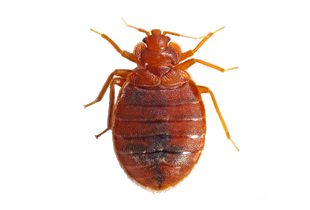

SPECIES: Cimex lectularius (order Hemiptera)
COMMON NAME: Bedbug
SIZE: Adult 4.0-5.0 x 3.0 mm
LIFECYCLE: A female lays from 200 to 500 eggs during its life, 20 to 50 at a time, that are white, ellipsoidal, with operculum, and measure 0.8 to 1.2 x 0.5 mm. The eggs are laid and glued with a special secretion that dries quickly, on beds, bedsteads, mattresses, etc. Breaking the operculum allows the young to emerge. It immediately wants to suck blood and takes 2-3 minutes to feed itself from a host. It becomes an adult after five moults. The nymphs are translucent, then pale yellow-amber, little longer than a millimeter, and very similar in shape to the parents, except for the lack of elytra. The full development (egg-adult) occurs on average over two months (21 days at 30 °C, 61 days at 23 °C, 34 days at 28 °C). The active life of an adult female usually lasts about 100 days. Adults can survive for twelve months without feeding and, in heated environments, up to two years. Adult females and 4th-stage nymphs are the toughest forms; the first nymphal stage is less resistant. At temperatures below 8° C, they fall into diapause. These insects are very sensitive to temperatures: while they can survive even at -15 °C for a few weeks, they succumb quickly to high temperatures. In fact, a temperature of 45°C is fatal to all stages of the insect's lifecycle, including the eggs.
FEATURES: The causes that may have led to their return in our country are due to the increased mobility of the population, deterioration of socio-economic conditions, use of specific products against natural predators (cockroaches, some species of spiders, ants, etc.), growth of hawkers of used furniture, and a more relaxed approach to some hygiene habits in relation to the care of mattresses, bedsteads, etc. The body colour varies from yellow-brown to dark red, depending on the blood eaten. It is covered with fine, dense yellow hair. The bed bug is a hematophagous, heterometabolic, wingless ectoparasite, whose main characteristic is to inflict its guests with long and repeated punctures with its hypodermic-sucking blood-sucking mouthparts.
HABITAT: In communities of larvae and adults, they spend the day in the joints and cracks of beds, walls, furniture, caves, in the seams of mattresses or chairs, and in electrical switches and ducting, where they lay their eggs and come out at night to feed. The shelters and trails of bedbugs are easily identified by the dark spots of their droppings.
DIET: the adult bedbug feeds every 3-7 days, but when the temperature is higher and the host is available, it feeds more frequently. The larvae must feed on blood before each moult. Hosts are recognised thanks to chemical and heat stimuli (carbon dioxide emissions), but not via odoriferous stimuli. The mandibles and jaws have evolved into stilettos, and used like a scalpel to pierce the skin. The jaws form two channels. The smallest is used to inject an anticoagulant saliva, while the largest sucks the blood and conveys it to the stomach. All this happens thanks to special muscles, inside the head, which act as powerful suction pumps and blowers to suck the blood and inject the saliva. The suction process lasts from 3 to 20 minutes.
DAMAGE: The sting of bugs is not noticeable while sucking blood, but the anticoagulant substances injected can cause reactions in some individuals that can lead to extended itchy swellings. The most affected areas are those most exposed during sleep, such as the face, neck, arms, hands and, rarely, around the waist. Asthmatic patients show a particular sensitivity to the antigens contained in the insect's stools, while children are subject to a wide range of allergic reactions. The role of the bedbug as a vector in the transmission of pathogens continues to be investigated. Scientific studies in the laboratory have demonstrated the ability of the insect to pass on about a dozen diseases, including leishmaniasis, American trypanosomiasis, Q fever, ulcers, and rickettsia. To date, there are no recorded cases of transmissions of such diseases.
DISINFESTATION METHODS: The recommended methods involve ULV sprays, cryo-disinfestation, and heat disinfestation.
I want to sterminate itFor the disinfestation of all areas, contact Gallura Disinfestazioni, a company specialized in disinfestation. Contact us for more information!